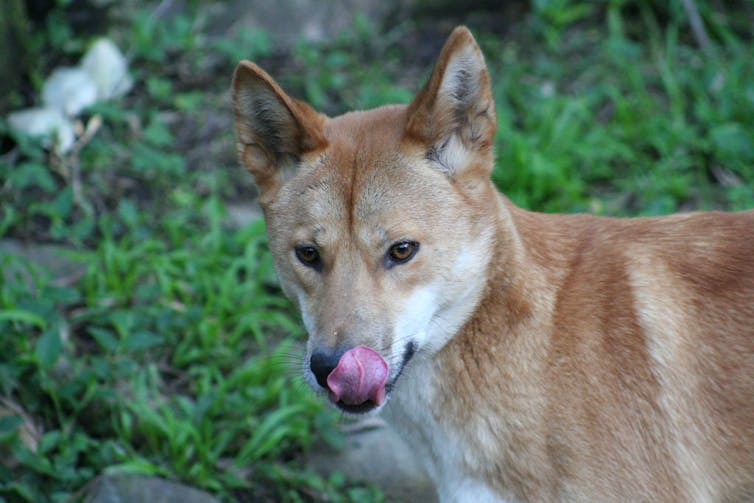Like cats and dogs: dingoes can keep feral cats in check
- Written by Mike Letnic, Professor, Centre for Ecosystem Science, UNSW
The role of dingoes in the Australian landscape is highly debated between ecologists, conservationists and graziers. They kill livestock, but also hunt introduced animals and keep kangaroo populations in check.
Now new research sheds more light on the benefits dingoes bring to the outback. For the first time, our research clearly shows that dingoes suppress feral cat numbers.
Our research, published recently in Ecosystems, used the world’s largest fence to compare essentially identical environments with and without dingoes. Over the course of the six-year study, dingoes drove down cat numbers – and kept them down.
Read more: A hidden toll: Australia's cats kill almost 650 million reptiles a year
Feral cats are a serious conservation threat. They have been linked to the extinction of at least 20 mammal species in Australia and threaten the ongoing survival of more than 100 native species.
For our study, we asked whether “top-down” pressure from dingoes (through direct killing and competition for food) had a greater influence on controlling cat numbers than “bottom-up” effects (the availability of shared food sources preyed on by cats).
 Dingoes drive down the population of introduced animals.
Kim/flickr, CC BY-SA
Dingoes drive down the population of introduced animals.
Kim/flickr, CC BY-SA
We conducted our study by comparing the numbers of dingoes, cats and their major prey species on either side of the dingo fence in the Strzelecki Desert. The fence runs along the borders of New South Wales and South Australia and was originally built to exclude dingoes from sheep grazing lands in NSW.
The state border follows the longitude line 141 east, so the fence does not demarcate any natural boundary. It simply cuts a straight line through sand dunes with similar landforms and vegetation on either side. Thus the dingo fence provides a unique opportunity to study apex predators’ effects on ecosystems: dingoes are common on the SA side, “outside” the fence, whereas on the NSW “inside” of the fence, dingoes are rare due to intensive persecution by humans.
Read more: Let's move the world's longest fence to settle the dingo debate
We collected data from sites on either side of the fence in the Strzelecki Desert, at roughly four-month intervals between 2011 and 2017. Dingo and cat scat was collected at each site, to analyse and compare diets, and spotlight searches were used to record numbers of dingoes, feral cats, as well as two of their common shared food sources: rabbits and hopping mice.
Spotlight surveys revealed dingoes to be virtually absent from study areas inside the fence, with only four dingoes recorded during the study. Where dingoes were rare inside the fence, cat numbers closely followed fluctuations of their prey species consistently over the six-year span of our study. As prey numbers increased, cat numbers also increased, and similarly as prey numbers declined, cat numbers also declined.
 A feral cat in outback Australia.
Shutterstock
A feral cat in outback Australia.
Shutterstock
Outside the fence, where dingoes were common, it was quite a different story. There, cat numbers were consistently lower, with numbers of both cats and dingoes following fluctuations in prey numbers across the first two years of the study. However, from 2013 onward, dingo numbers remained high and matched trends in their prey numbers for the remainder of the study.
During this time, cat numbers remained low, and by the end of 2015, cats had virtually disappeared from our study sites outside the fence and were not recorded during spotlight surveys between November 2015 and the end of our study in July 2017.
The most likely explanation for this drastic reduction in cat populations is through interference competition – either by dingoes killing some cats or by scaring others away from habitats in which they would usually hunt. Indeed, we occasionally found cat remains in dingo scats, which suggests dingoes prey on cats.
Although our scat analyses indicated that dingoes and cats eat similar foods, there was no evidence that competition for food was a major factor in how dingoes reduce cat populations. This is because prey were plentiful outside the fence, where dingoes were common and cats were rare.
Read more: Why do some graziers want to retain, not kill, dingoes?
This research show how dingoes can help conservation efforts by suppressing feral cat populations. It adds to previous work showing dingoes are important in maintaining healthy ecosystems, as they reduce and eradicate feral herbivores like pigs and goats, and stop kangaroos from overpopulating districts.
This article was updated on April 5 to credit Ben Feit as a co-author.
Authors: Mike Letnic, Professor, Centre for Ecosystem Science, UNSW
Read more http://theconversation.com/like-cats-and-dogs-dingoes-can-keep-feral-cats-in-check-114748



